The Petrogenesis and Geological Implications of the Sanggeda Gabbros, Southern Tibet: Insights from the Amphibole Crystal Population
Abstract
1. Introduction
2. Geological Setting and Field Relationships
3. Sampling Strategy, Analytical Methods, and Results
3.1. Sampling Strategy
3.2. Analytical Methods
3.3. Petrology and Mineralogical Characteristics
3.4. Major Element Composition: EPMA Results
3.4.1. Amphibole
3.4.2. Clinopyroxene
3.5. Trace Element Composition: LA–ICP–MS Result
3.5.1. Amphibole
3.5.2. Clinopyroxene
4. Discussion
4.1. Genesis of Amphibole Crystal Population
4.1.1. The Source of Amphibole Crystal Population: Autocryst and Antecryst
4.1.2. Crystallization Conditions for Amphibole
4.1.3. The Crystallization Process of Amphibole Crystal Population
4.2. Petrogenesis of the Sanggeda Intrusion: A Trans-Crustal Magma Plumbing System
5. Conclusions
- (1)
- The amphibole crystal population from the intrusion can be divided into four categories: the fined-grained euhedral amphiboles (Type 1) that crystallized from the host magma autocryst; euhedral amphiboles (Type 2) that crystallized from magma after plagioclase fractionation; euhedral amphiboles (Type 3) formed in a lower crust magma chamber; and amphiboles as clinopyroxene pseudomorphs, formed by reaction–replacement of clinopyroxene (Type 4). Amphibole Types 2–4 are classified as antecrysts.
- (2)
- The heterogeneity of the intrusion is attributed to the combination of polybaric fractional crystallization and rock–melt reactions. A trans-crustal magma plumbing system with multiple magma chambers is proposed, through which amphiboles and other minerals of varied origins were incorporated into the ascending magmas, forming the Sanggeda intrusion.
Supplementary Materials
Author Contributions
Funding
Institutional Review Board Statement
Informed Consent Statement
Data Availability Statement
Acknowledgments
Conflicts of Interest
References
- Taylor, S.R.; Mclennan, S.M. The Continental Crust: Its Composition and Evolution; Blackwell Scientific Publications: Oxford, UK, 1985. [Google Scholar]
- Rudnick, R.L. Making continental crust. Nature 1995, 378, 571–578. [Google Scholar] [CrossRef]
- Rudnick, R.; Gao, S.; Holland, H.; Turekian, K. Composition of the continental crust. Crust 2003, 3, 1–64. [Google Scholar]
- Zhu, R.; Zhao, G.; Xiao, W.; Chen, L.; Tang, Y. Origin, accretion, and reworking of continents. Rev. Geophys. 2021, 59, e2019RG000689. [Google Scholar] [CrossRef]
- Smithies, R.H.; Lu, Y.; Kirkland, C.L.; Johnson, T.E.; Mole, D.R.; Champion, D.C.; Martin, L.; Jeon, H.; Wingate, M.T.D.; Johnson, S.P. Oxygen isotopes trace the origins of Earth’s earliest continental crust. Nature 2021, 592, 70–75. [Google Scholar] [CrossRef]
- Annen, C.; Blundy, J.D.; Sparks, R.S.J. The genesis of intermediate and silicic magmas in deep crustal hot zones. J. Petrol. 2006, 47, 505–539. [Google Scholar] [CrossRef]
- Hawkesworth, C.J.; Kemp, A.I.S. The differentiation and rates of generation of the continental crust. Chem. Geol. 2006, 226, 134–143. [Google Scholar] [CrossRef]
- Arculus, R.J. Aspects of magma genesis in arcs. Lithos 1994, 33, 189–208. [Google Scholar] [CrossRef]
- Macdonald, R.; Hawkesworth, C.J.; Heath, E. The Lesser Antilles volcanic chain: A study in arc magmatism. Earth Sci. Rev. 2000, 49, 1–76. [Google Scholar] [CrossRef]
- Jerram, D.A.; Martin, V.M. Understanding crystal populations and their significance through the magma plumbing system. Geol. Soc. Lond. Spec. Publ. 2008, 304, 133–148. [Google Scholar] [CrossRef]
- Davidson, J.P.; Morgan, D.J.; Charlier, B.L.A.; Harlou, R.; Hora, J.M. Microsampling and isotopic analysis of igneous rocks: Implications for the study of magmatic systems. Annu. Rev. Earth Planet. Sci. 2007, 35, 273–311. [Google Scholar] [CrossRef]
- Davidson, J.; Turner, S.; Handley, H.; Macpherson, C.; Dosseto, A. Amphibole “sponge” in arc crust? Geology 2007, 35, 787–790. [Google Scholar] [CrossRef]
- Kratzmann, D.J.; Carey, S.; Scasso, R.A.; Naranjo, J.-A. Role of cryptic amphibole crystallization in magma differentiation at Hudson volcano, southern Volcanic Zone, Chile. Contrib. Mineral. Petrol. 2009, 159, 237–264. [Google Scholar] [CrossRef]
- Tiepolo, M.; Tribuzio, R. Petrology and U-Pb zircon geochronology of amphibole-rich cumulates with sanukitic affinity from Husky Ridge (Northern Victoria Land, Antarctica): Insights into the role of amphibole in the petrogenesis of subduction-related magmas. J. Petrol. 2008, 49, 937–970. [Google Scholar] [CrossRef]
- Rutherford, M.J.; Devine, J.D. The May 18, 1980, eruption of Mount St. Helens: 3. Stability and chemistry of amphibole in the magma chamber. J. Geophys. Res. Solid Earth 1988, 93, 11949–11959. [Google Scholar] [CrossRef]
- Romick, J.D.; Kay, S.M.; Kay, R.W. The influence of amphibole fractionation on the evolution of calc-alkaline andesite and dacite tephra from the central Aleutians, Alaska. Contrib. Mineral. Petrol. 1992, 112, 101–118. [Google Scholar] [CrossRef]
- Larocque, J.; Canil, D. The role of amphibole in the evolution of arc magmas and crust: The case from the Jurassic Bonanza arc section, Vancouver Island, Canada. Contrib. Mineral. Petrol. 2010, 159, 475–492. [Google Scholar] [CrossRef]
- Langmuir, C.H. Geochemical consequences of in situ crystallization. Nature 1989, 340, 199–205. [Google Scholar] [CrossRef]
- Smith, D.J. Clinopyroxene precursors to amphibole sponge in arc crust. Nat. Commun. 2014, 5, 4329. [Google Scholar] [CrossRef]
- Tiepolo, M.; Tribuzio, R. Slab-melting during Alpine orogeny: Evidence from mafic cumulates of the Adamello batholith (Central Alps, Italy). Chem. Geol. 2005, 216, 271–288. [Google Scholar] [CrossRef]
- Tiepolo, M.; Tribuzio, R.; Langone, A. High-Mg andesite petrogenesis by amphibole crystallization and ultramafic crust assimilation: Evidence from Adamello hornblendites (Central Alps, Italy). J. Petrol. 2011, 52, 1011–1045. [Google Scholar] [CrossRef]
- Dessimoz, M.; Müntener, O.; Ulmer, P. A case for hornblende dominated fractionation of arc magmas: The Chelan Complex (Washington Cascades). Contrib. Mineral. Petrol. 2011, 163, 567–589. [Google Scholar] [CrossRef]
- Wang, J.; Wang, Q.; Dan, W.; Yang, J.H.; Yang, Z.Y.; Sun, P.; Qi, Y.; Hu, W.L. The role of clinopyroxene in amphibole fractionation of arc magmas: Evidence from mafic intrusive rocks within the Gangdese arc, southern Tibet. Lithos 2019, 338–339, 174–188. [Google Scholar] [CrossRef]
- Xu, W.; Zhu, D.C.; Wang, Q.; Weinberg, R.F.; Wang, R.; Li, S.M.; Zhang, L.L.; Zhao, Z.D. Constructing the early Mesozoic Gangdese Crust in southern Tibet by hornblende-dominated magmatic differentiation. J. Petrol. 2019, 60, 515–552. [Google Scholar] [CrossRef]
- Xu, W.; Zhu, D.C.; Wang, Q.; Weinberg, R.F.; Wang, R.; Li, S.M.; Zhang, L.L.; Zhao, Z.D. Cumulate mush hybridization by melt invasion: Evidence from compositionally-diverse amphiboles in ultramafic-mafic arc cumulates within the eastern Gangdese Batholith, southern Tibet. J. Petrol. 2021, 62, egab073. [Google Scholar] [CrossRef]
- Sisson, T.W.; Grove, T.L. Experimental investigations of the role of H2O in calc-alkaline differentiation and subduction zone magmatism. Contrib. Mineral. Petrol. 1993, 113, 143–166. [Google Scholar] [CrossRef]
- Humphreys, M.C.S.; Zhang, J.; Cooper, G.F.; Macpherson, C.G.; Ottley, C.J. Identifying the ingredients of hydrous arc magmas: Insights from Mt Lamington, Papua New Guinea. Philos. Trans. R. Soc. Ser. A 2019, 377, 20180018. [Google Scholar] [CrossRef]
- Larrea, P.; França, Z.; Lago, M.; Widom, E.; Galé, C.; Ubide, T. Magmatic processes and the role of antecrysts in the genesis of Corvo Island (Azores Archipelago, Portugal). J. Petrol. 2013, 54, 769–793. [Google Scholar] [CrossRef]
- Melekhova, E.; Blundy, J.; Robertson, R.; Humphreys, M.C.S. Experimental evidence for polybaric differentiation of primitive arc basalt beneath St. Vincent, Lesser Antilles. J. Petrol. 2015, 56, 161–192. [Google Scholar] [CrossRef]
- Ulmer, P. Differentiation of mantle-derived calc-alkaline magmas at mid to lower crustal levels: Experimental and petrologic constraints. Period. Mineral. 2007, 76, 309–325. [Google Scholar] [CrossRef]
- Tiepolo, M.; Langone, A.; Morishita, T.; Yuhara, M. On the recycling of amphibole-rich ultramafic intrusive rocks in the arc crust: Evidence from Shikanoshima Island (Kyushu, Japan). J. Petrol. 2012, 53, 1255–1285. [Google Scholar] [CrossRef]
- Zhu, D.C.; Wang, Q.; Cawood, P.A.; Zhao, Z.D.; Mo, X.X. Raising the Gangdese mountains in southern Tibet. J. Geophys. Res. Solid Earth 2017, 122, 214–223. [Google Scholar] [CrossRef]
- Yin, A.; Harrison, T.M. Geologic evolution of the Himalayan-Tibetan orogen. Annu. Rev. Earth Planet. Sci. 2000, 28, 211–280. [Google Scholar] [CrossRef]
- Zhu, D.C.; Zhao, Z.D.; Niu, Y.L.; Dilek, Y.; Hou, Z.Q.; Mo, X.X. The origin and pre-Cenozoic evolution of the Tibetan Plateau. Gondwana Res. 2013, 23, 1429–1454. [Google Scholar] [CrossRef]
- Aitchison, J.C.; Badengzhu; Davis, A.M.; Liu, J.; Luo, H.; Malpas, J.G.; McDermid, I.R.; Wu, H.; Ziabrev, S.V.; Zhou, M.-F. Remnants of a Cretaceous intra-oceanic subduction system within the Yarlung–Zangbo suture (southern Tibet). Earth Planet. Sci. Lett. 2000, 183, 231–244. [Google Scholar] [CrossRef]
- Aitchison, J.C.; Davis, A.M.; Abrajevitch, A.V.; Ali, J.R.; Badengzhu; Liu, J.; Luo, H.; McDermid, I.R.C.; Ziabrev, S.V. Stratigraphic and sedimentological constraints on the age and tectonic evolution of the Neotethyan ophiolites along the Yarlung Tsangpo suture zone, Tibet. Geol. Soc. Lond. Spec. Publ. 2003, 218, 147–164. [Google Scholar] [CrossRef]
- McDermid, I.R.; Aitchison, J.C.; Davis, A.M.; Harrison, T.M.; Grove, M. The Zedong terrane: A Late Jurassic intra-oceanic magmatic arc within the Yarlung–Tsangpo suture zone, southeastern Tibet. Chem. Geol. 2002, 187, 267–277. [Google Scholar] [CrossRef]
- Ma, X.; Meert, J.G.; Xu, Z.; Yi, Z. Late Triassic intra-oceanic arc system within Neotethys: Evidence from cumulate appinite in the Gangdese belt, southern Tibet. Lithosphere 2018, 10, 545–565. [Google Scholar] [CrossRef]
- Chu, M.F.; Chung, S.L.; Song, B.; Liu, D.; O’Reilly, S.Y.; Pearson, N.J.; Ji, J.; Wen, D.J. Zircon U-Pb and Hf isotope constraints on the Mesozoic tectonics and crustal evolution of southern Tibet. Geology 2006, 34, 745–748. [Google Scholar] [CrossRef]
- Ji, W.Q.; Wu, F.Y.; Chung, S.L.; Li, J.X.; Liu, C.Z. Zircon U-Pb geochronology and Hf isotopic constraints on petrogenesis of the Gangdese batholith, southern Tibet. Chem. Geol. 2009, 262, 229–245. [Google Scholar] [CrossRef]
- Wen, D.R.; Liu, D.; Chung, S.L.; Chu, M.F.; Ji, J.; Zhang, Q.; Song, B.; Lee, T.Y.; Yeh, M.W.; Lo, C.H. Zircon SHRIMP U-Pb ages of the Gangdese Batholith and implications for Neotethyan subduction in southern Tibet. Chem. Geol. 2008, 252, 191–201. [Google Scholar] [CrossRef]
- Jing, W. Discovery of the Sanggeda Hornblende Gabbro in Zedong, Tibet: Evidence of the Closure Time of the Yarlung-Zangbo Suture Zone. Master’s Thesis, China University of Geosciences, Beijing, China, 2017. [Google Scholar]
- Liu, Y.; Hu, Z.; Gao, S.; Günther, D.; Xu, J.; Gao, C.; Chen, H. In situ analysis of major and trace elements of anhydrous minerals by LA-ICP-MS without applying an internal standard. Chem. Geol. 2008, 257, 34–43. [Google Scholar] [CrossRef]
- Liu, Y.; Gao, S.; Hu, Z.; Gao, C.; Zong, K.; Wang, D. Continental and oceanic crust recycling-induced melt-peridotite interactions in the Trans-North China Orogen: U-Pb dating, Hf isotopes and trace elements in zircons from mantle xenoliths. J. Petrol. 2010, 51, 537–571. [Google Scholar] [CrossRef]
- Leake, B.E.; Woolley, A.R.; Arps, C.E.; Birch, W.D.; Gilbert, M.C.; Grice, J.D.; Hawthorne, F.C.; Kato, A.; Kisch, H.J.; Krivovichev, V.G. Nomenclature of amphiboles; Report of the Subcommittee on Amphiboles of the International Mineralogical Association Commission on new minerals and mineral names. Mineral. Mag. 1997, 61, 295–310. [Google Scholar] [CrossRef]
- Leake, B.E.; Woolley, A.R.; Birch, W.D.; Burke, E.A.J.; Ferraris, G.; Grice, J.D.; Hawthorne, F.C.; Kisch, H.J.; Krivovichev, V.G.; Schumacher, J.C.; et al. Nomenclature of amphiboles: Additions and revisions to the International Mineralogical Association’s amphibole nomenclature. Mineral. Mag. 2004, 68, 209–215. [Google Scholar] [CrossRef]
- Hawthorne, F.C.; Oberti, R.; Harlow, G.E.; Maresch, W.V.; Martin, R.F.; Schumacher, J.C.; Welch, M.D. Nomenclature of the amphibole supergroup. Am. Mineral. 2012, 97, 2031–2048. [Google Scholar] [CrossRef]
- Schumacher, J. The estimation of the proportion of ferric iron in the electron-microprobe analysis of amphiboles. Can. Mineral. 1997, 35, 238–246. [Google Scholar]
- Hawthorne, F.; Oberti, R. Amphiboles: Crystal Chemistry. Rev. Mineral. Geochem. 2007, 67, 1–54. [Google Scholar] [CrossRef]
- Morimoto, N. Nomenclature of pyroxenes. Mineral. Petrol. 1988, 39, 55–76. [Google Scholar] [CrossRef]
- Sun, S.S.; McDonough, W.F. Chemical and isotopic systematics of oceanic basalts: Implications for mantle composition and processes. Geol. Soc. Lond. Spec. Publ. 1989, 42, 313–345. [Google Scholar] [CrossRef]
- Rhodes, J.M.; Dungan, M.A.; Blanchard, D.P.; Long, P.E. Magma mixing at mid-ocean ridges: Evidence from basalts drilled near 22° N on the Mid-Atlantic Ridge. Tectonophysics 1979, 55, 35–61. [Google Scholar] [CrossRef]
- Putirka, K. Amphibole thermometers and barometers for igneous systems and some implications for eruption mechanisms of felsic magmas at arc volcanoes. Am. Mineral. 2016, 101, 841–858. [Google Scholar] [CrossRef]
- Ubide, T.; Galé, C.; Larrea, P.; Arranz, E.; Lago, M. Antecrysts and their effect on rock compositions: The Cretaceous lamprophyre suite in the Catalonian Coastal Ranges (NE Spain). Lithos 2014, 206–207, 214–233. [Google Scholar] [CrossRef]
- Ridolfi, F.; Renzulli, A.; Puerini, M. Stability and chemical equilibrium of amphibole in calc-alkaline magmas: An overview, new thermobarometric formulations and application to subduction-related volcanoes. Contrib. Mineral. Petrol. 2010, 160, 45–66. [Google Scholar] [CrossRef]
- Erdmann, S.; Martel, C.; Pichavant, M.; Kushnir, A. Amphibole as an archivist of magmatic crystallization conditions: Problems, potential, and implications for inferring magma storage prior to the paroxysmal 2010 eruption of Mount Merapi, Indonesia. Contrib. Mineral. Petrol. 2014, 167, 1016. [Google Scholar] [CrossRef]
- Molina, J.F.; Moreno, J.A.; Castro, A.; Rodríguez, C.; Fershtater, G.B. Calcic amphibole thermobarometry in metamorphic and igneous rocks: New calibrations based on plagioclase/amphibole Al-Si partitioning and amphibole/liquid Mg partitioning. Lithos 2015, 232, 286–305. [Google Scholar] [CrossRef]
- Müntener, O.; Kelemen, P.B.; Grove, T.L. The role of H2O during crystallization of primitive arc magmas under uppermost mantle conditions and genesis of igneous pyroxenites: An experimental study. Contrib. Mineral. Petrol. 2001, 141, 643–658. [Google Scholar] [CrossRef]
- Holland, T.; Blundy, J. Non-ideal interactions in calcic amphiboles and their bearing on amphibole-plagioclase thermometry. Contrib. Mineral. Petrol. 1994, 116, 433–447. [Google Scholar] [CrossRef]
- Krawczynski, M.J.; Grove, T.L.; Behrens, H. Amphibole stability in primitive arc magmas: Effects of temperature, H2O content, and oxygen fugacity. Contrib. Mineral. Petrol. 2012, 164, 317–339. [Google Scholar] [CrossRef]
- Claeson, D.T.; Meurer, W.P. Fractional crystallization of hydrous basaltic “arc-type” magmas and the formation of amphibole-bearing gabbroic cumulates. Contrib. Mineral. Petrol. 2004, 147, 288–304. [Google Scholar] [CrossRef]
- Plank, T.; Kelley, K.A.; Zimmer, M.M.; Hauri, E.H.; Wallace, P.J. Why do mafic arc magmas contain ~4wt% water on average? Earth Planet. Sci. Lett. 2013, 364, 168–179. [Google Scholar] [CrossRef]
- Borghini, G.; Fumagalli, P.; Rampone, E. The stability of plagioclase in the upper mantle: Subsolidus experiments on fertile and depleted lherzolite. J. Petrol. 2009, 51, 229–254. [Google Scholar] [CrossRef]
- Namur, O.; Charlier, B.; Toplis, M.J.; Vander Auwera, J. Prediction of plagioclase-melt equilibria in anhydrous silicate melts at 1-atm. Contrib. Mineral. Petrol. 2011, 163, 133–150. [Google Scholar] [CrossRef]
- Takagi, D.; Sato, H.; Nakagawa, M. Experimental study of a low-alkali tholeiite at 1-5 kbar: Optimal condition for the crystallization of high-An plagioclase in hydrous arc tholeiite. Contrib. Mineral. Petrol. 2005, 149, 527–540. [Google Scholar] [CrossRef]
- Weaver, S.L.; Wallace, P.J.; Johnston, A.D. A comparative study of continental vs. intraoceanic arc mantle melting: Experimentally determined phase relations of hydrous primitive melts. Earth Planet. Sci. Lett. 2011, 308, 97–106. [Google Scholar] [CrossRef]
- Wang, C.; Liang, Y.; Xu, W. Formation of amphibole-bearing peridotite and amphibole-bearing pyroxenite through hydrous melt-peridotite reaction and in situ crystallization: An experimental study. J. Geophys. Res. Solid Earth 2021, 126, e2020JB019382. [Google Scholar] [CrossRef]
- Cooper, G.F.; Davidson, J.P.; Blundy, J.D. Plutonic xenoliths from Martinique, Lesser Antilles: Evidence for open system processes and reactive melt flow in island arc crust. Contrib. Mineral. Petrol. 2016, 171, 87. [Google Scholar] [CrossRef]
- Rooney, T.O.; Franceschi, P.; Hall, C.M. Water-saturated magmas in the Panama Canal region: A precursor to adakite-like magma generation? Contrib. Mineral. Petrol. 2010, 161, 373–388. [Google Scholar] [CrossRef]
- Rutherford, M.J.; Hill, P.M. Magma ascent rates from amphibole breakdown: An experimental study applied to the 1980-1986 Mount St. Helens eruptions. J. Geophys. Res. Solid Earth 1993, 98, 19667–19685. [Google Scholar] [CrossRef]
- Burchardt, S. Volcanic and Igneous Plumbing Systems: Understanding Magma Transport, Storage, and Evolution in the Earth’s Crust; Elsevier: Amsterdam, The Netherlands, 2018; pp. 1–341. [Google Scholar]
- Cashman, K.V.; Sparks, R.S.; Blundy, J.D. Vertically extensive and unstable magmatic systems: A unified view of igneous processes. Science 2017, 355, eaag3055. [Google Scholar] [CrossRef]
- Magee, C.; Stevenson, C.T.E.; Ebmeier, S.K.; Keir, D.; Hammond, J.O.S.; Gottsmann, J.H.; Whaler, K.A.; Schofield, N.; Jackson, C.A.L.; Petronis, M.S.; et al. Magma plumbing systems: A geophysical perspective. J. Petrol. 2018, 59, 1217–1251. [Google Scholar] [CrossRef]
- Jackson, M.D.; Blundy, J.; Sparks, R.S.J. Chemical differentiation, cold storage and remobilization of magma in the earth’s crust. Nature 2018, 564, 405–409. [Google Scholar] [CrossRef]

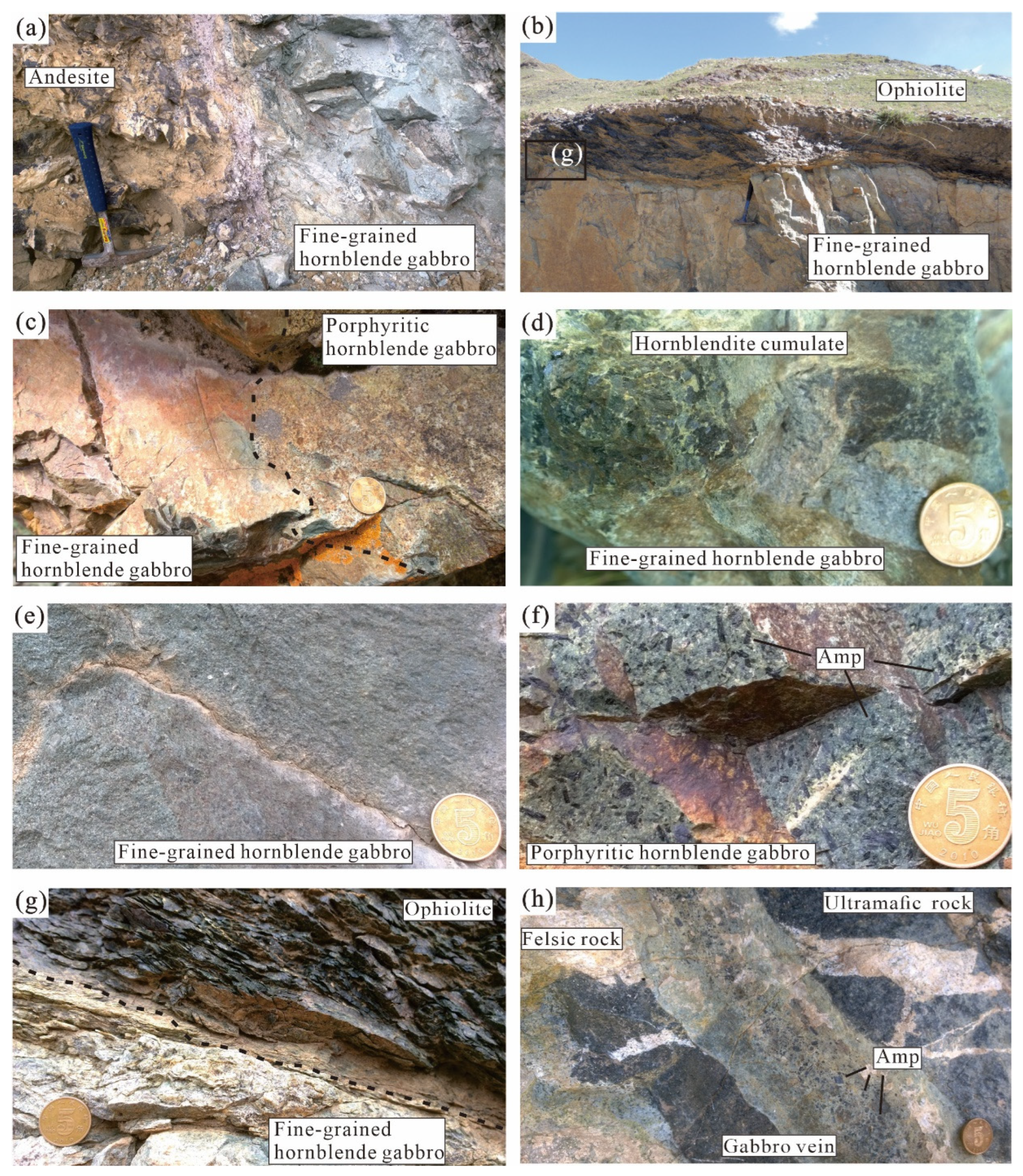
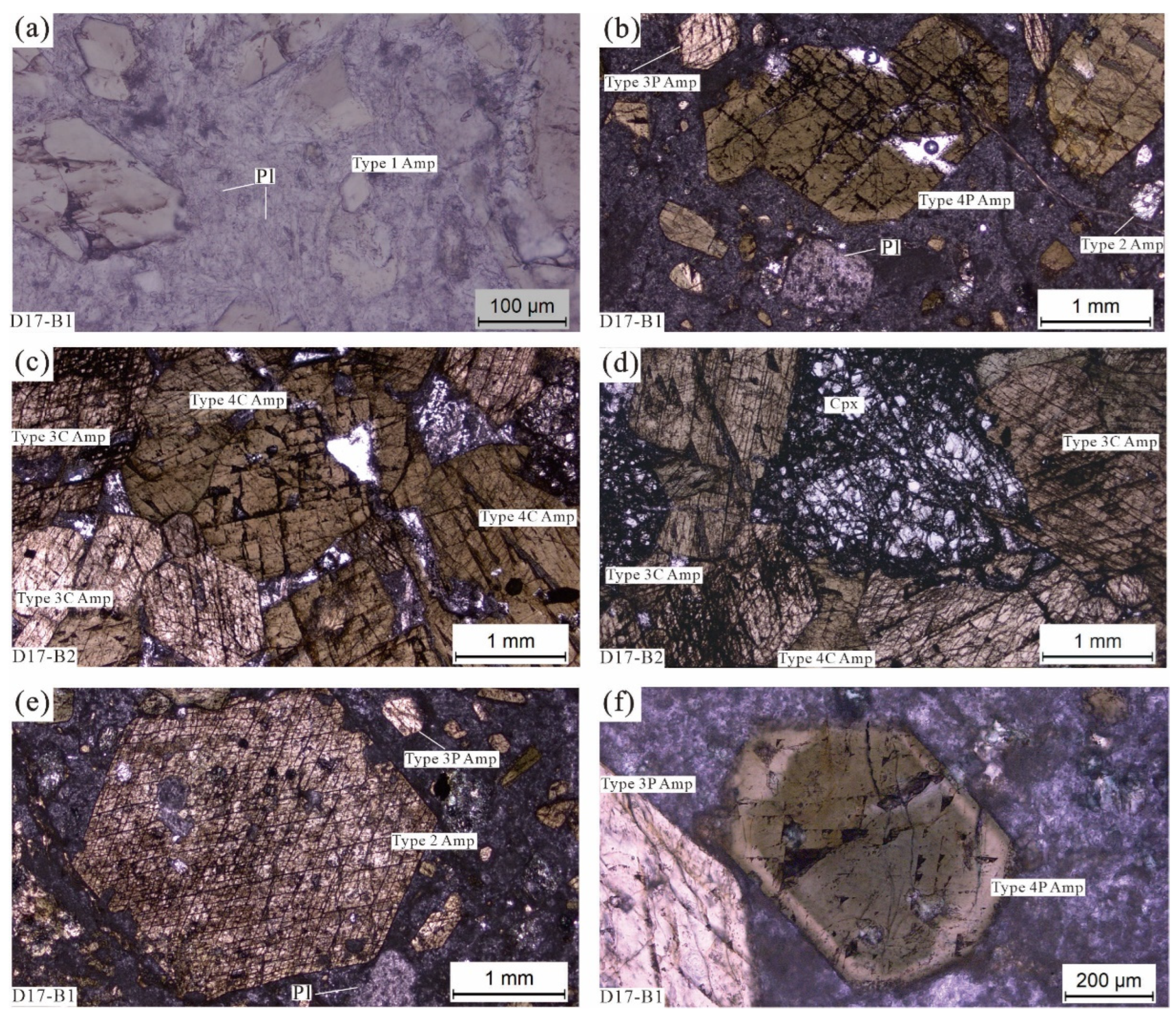
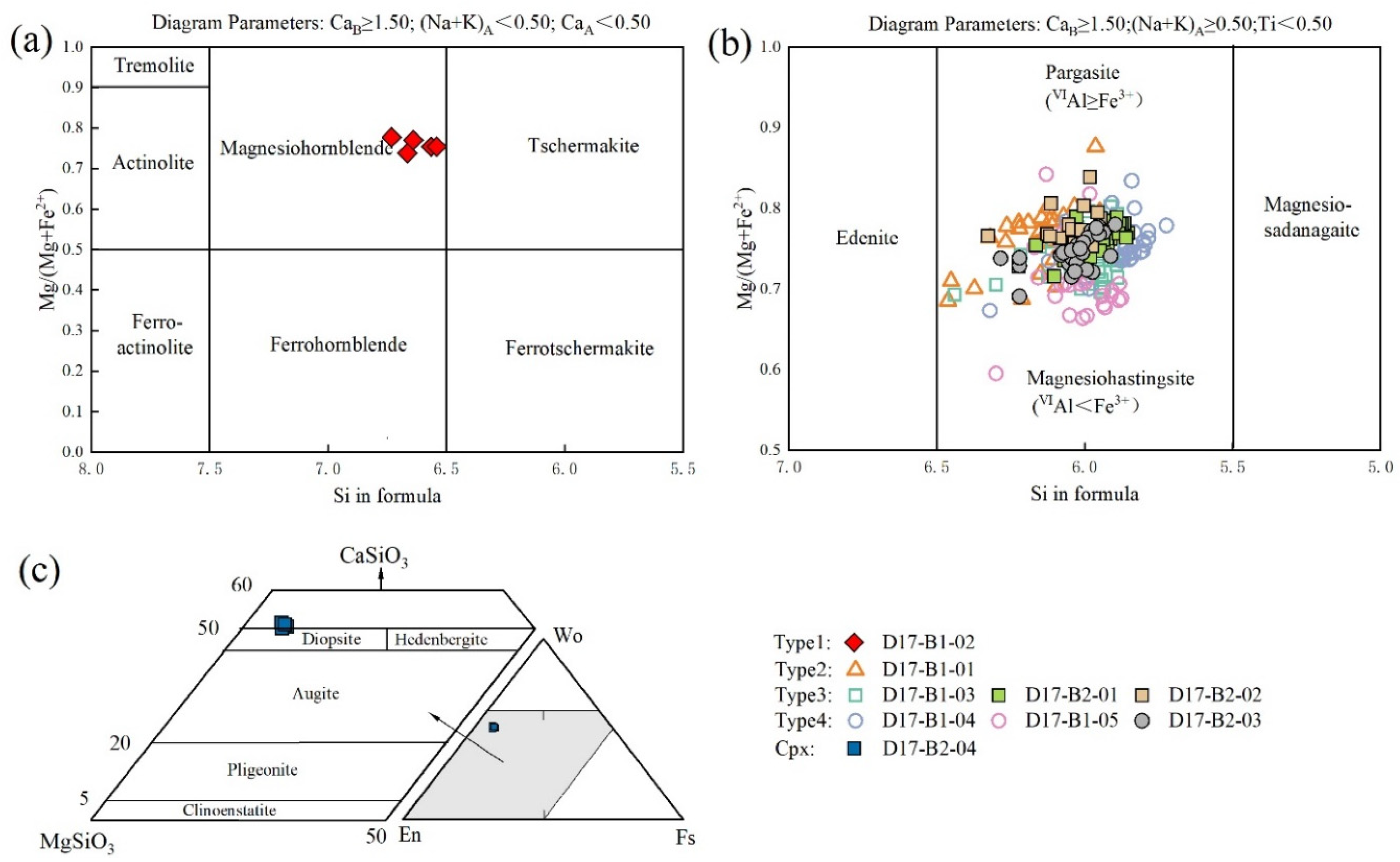
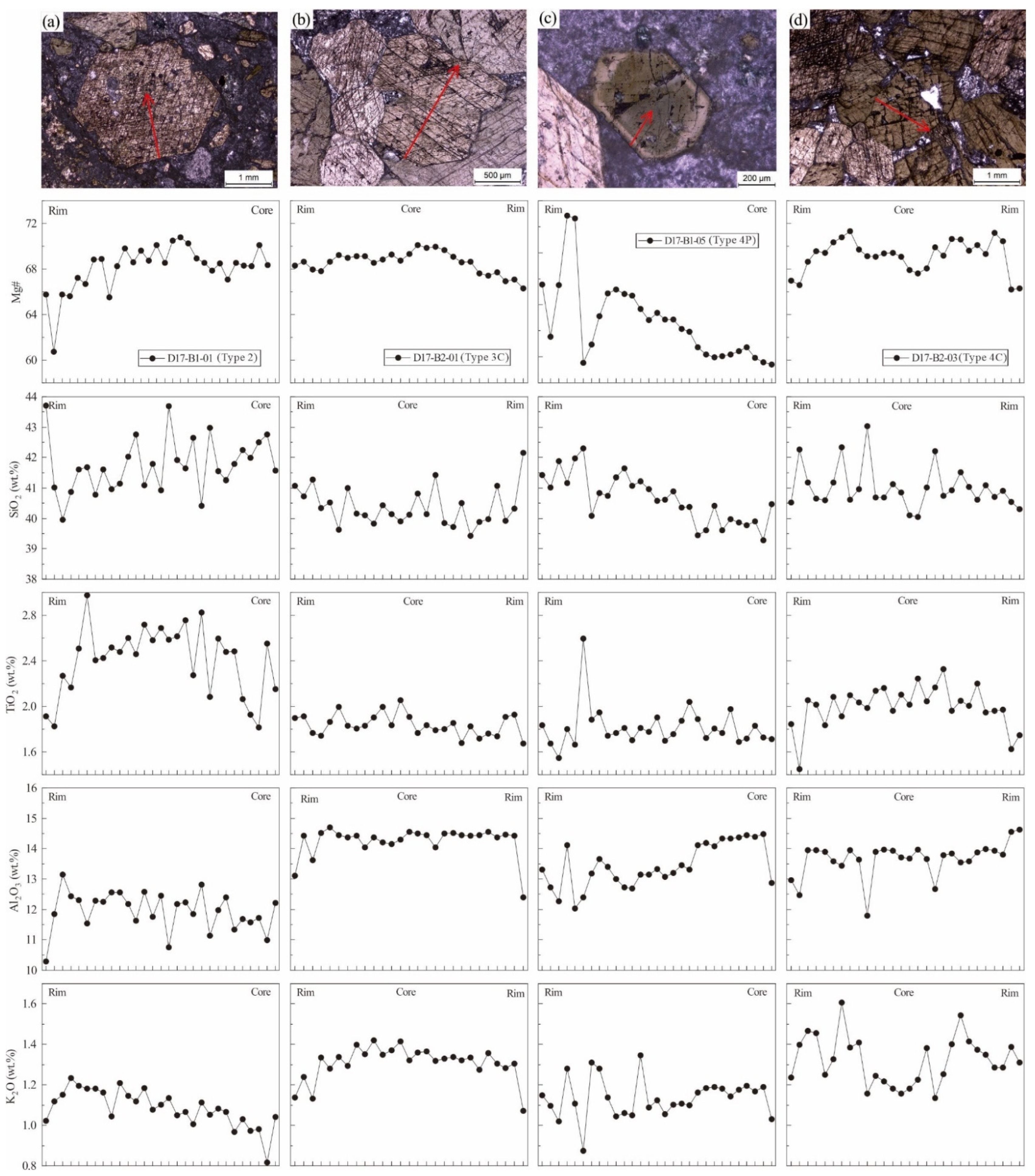
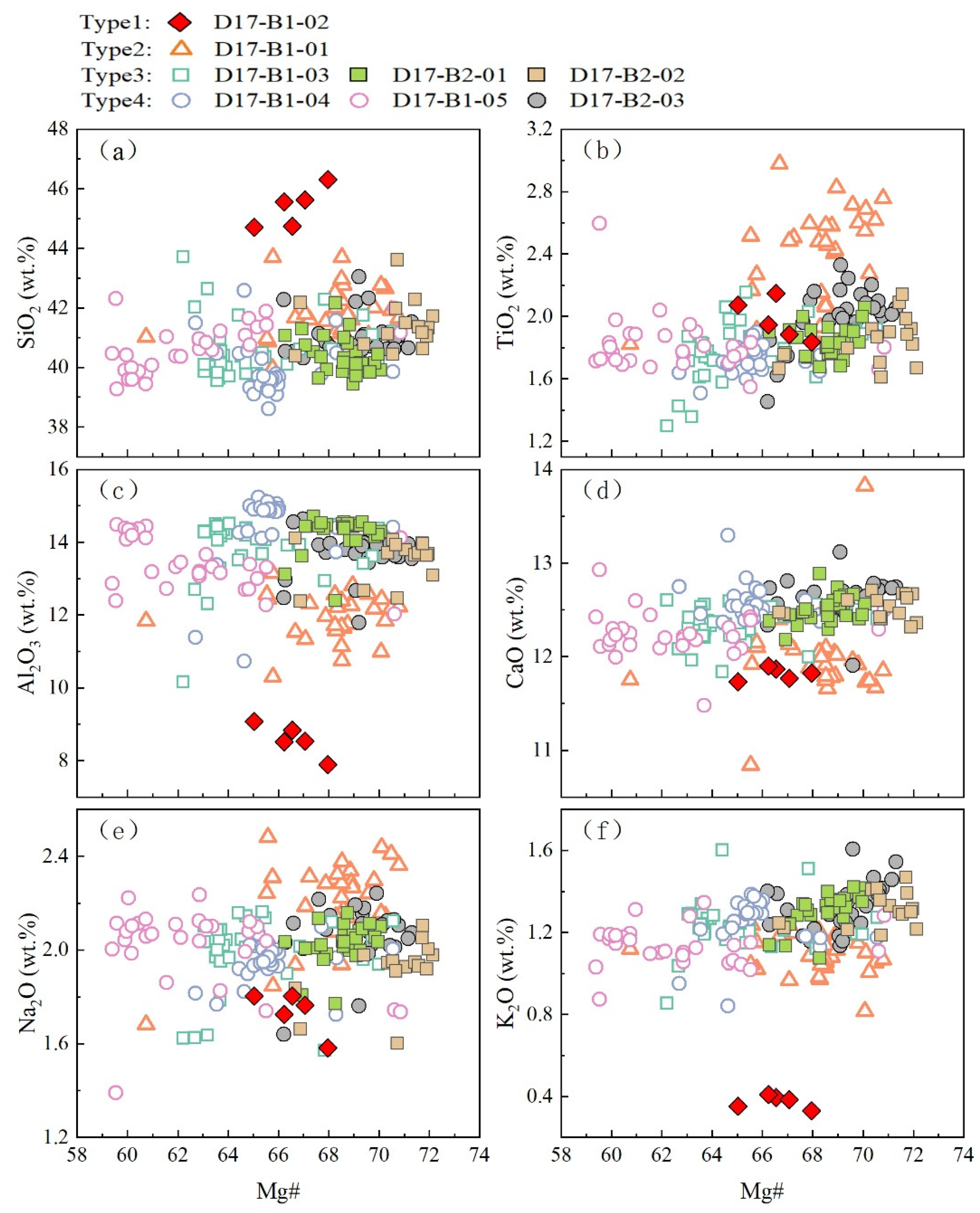

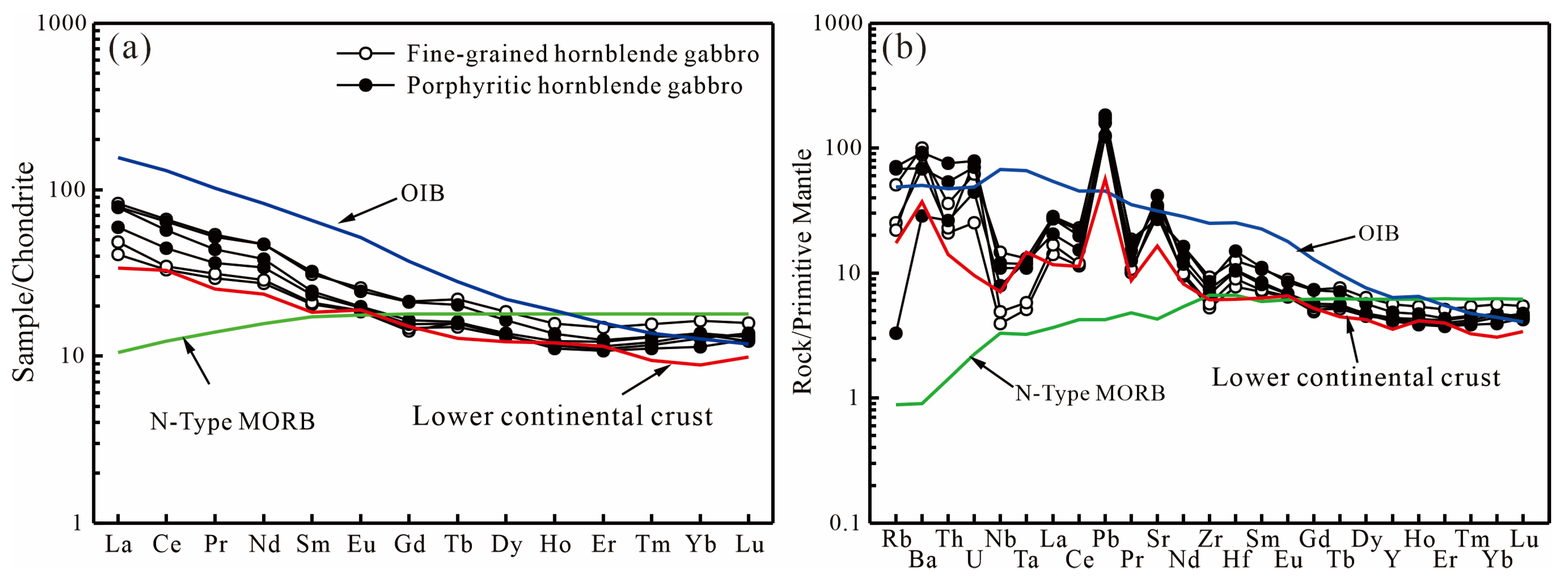
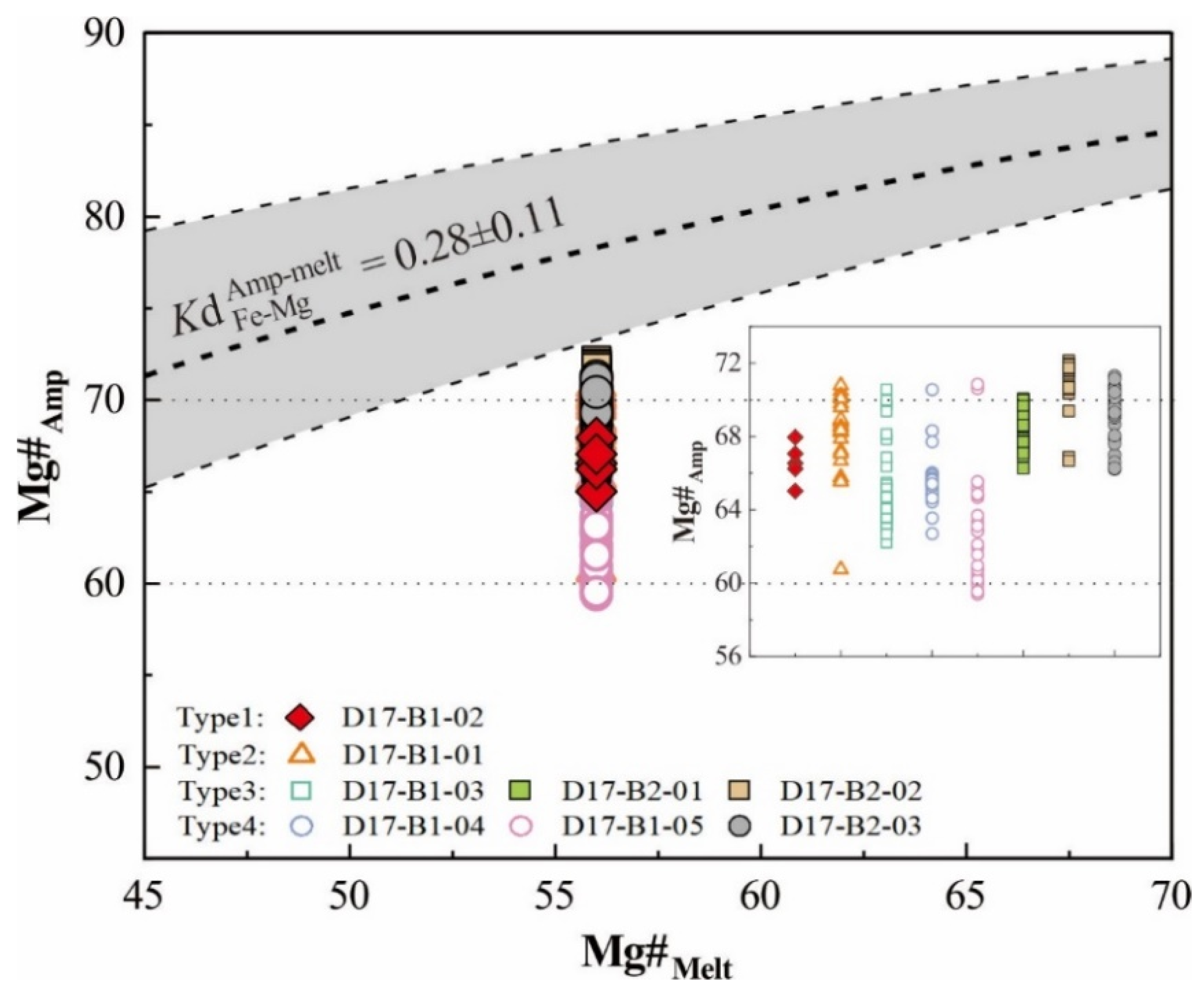
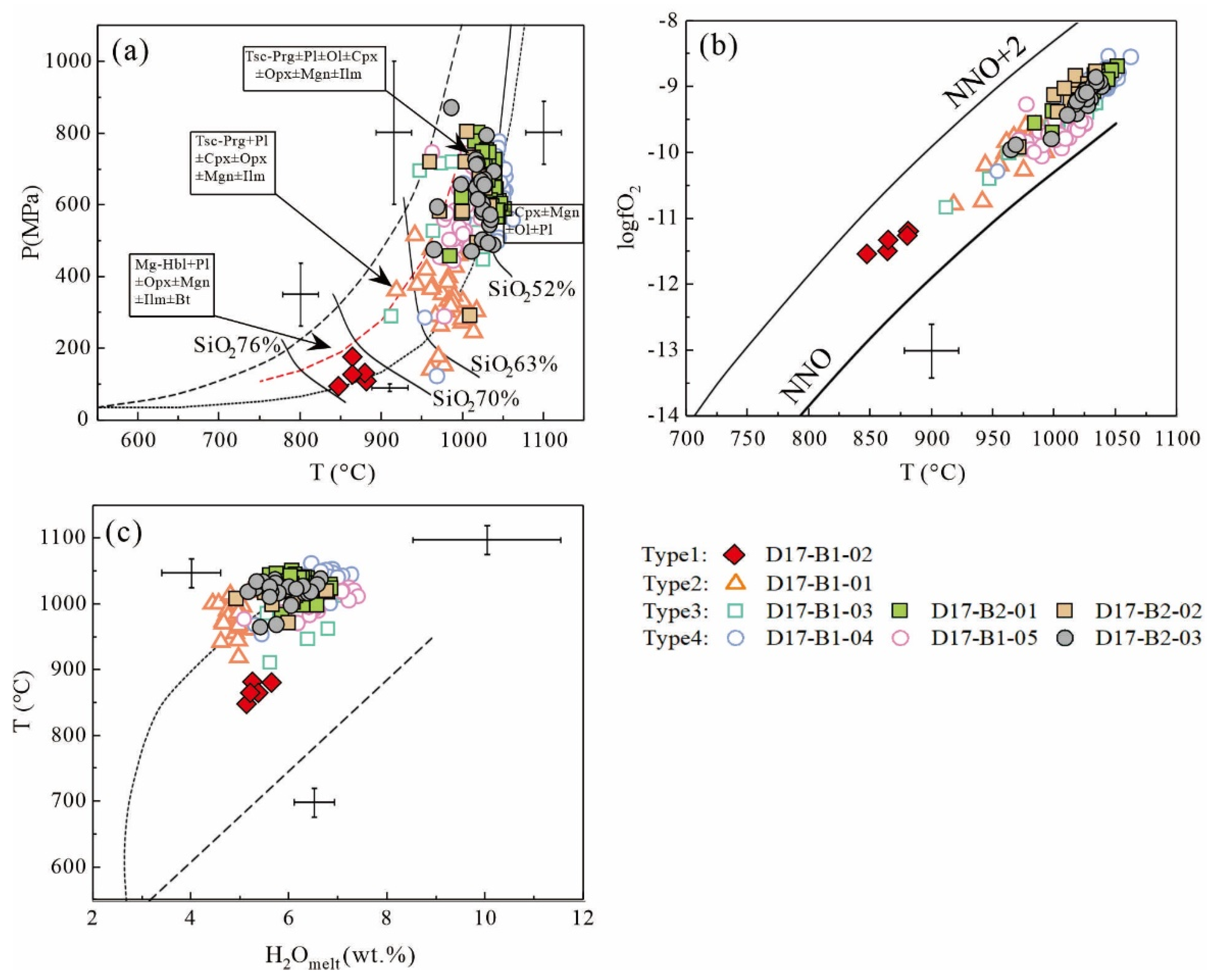
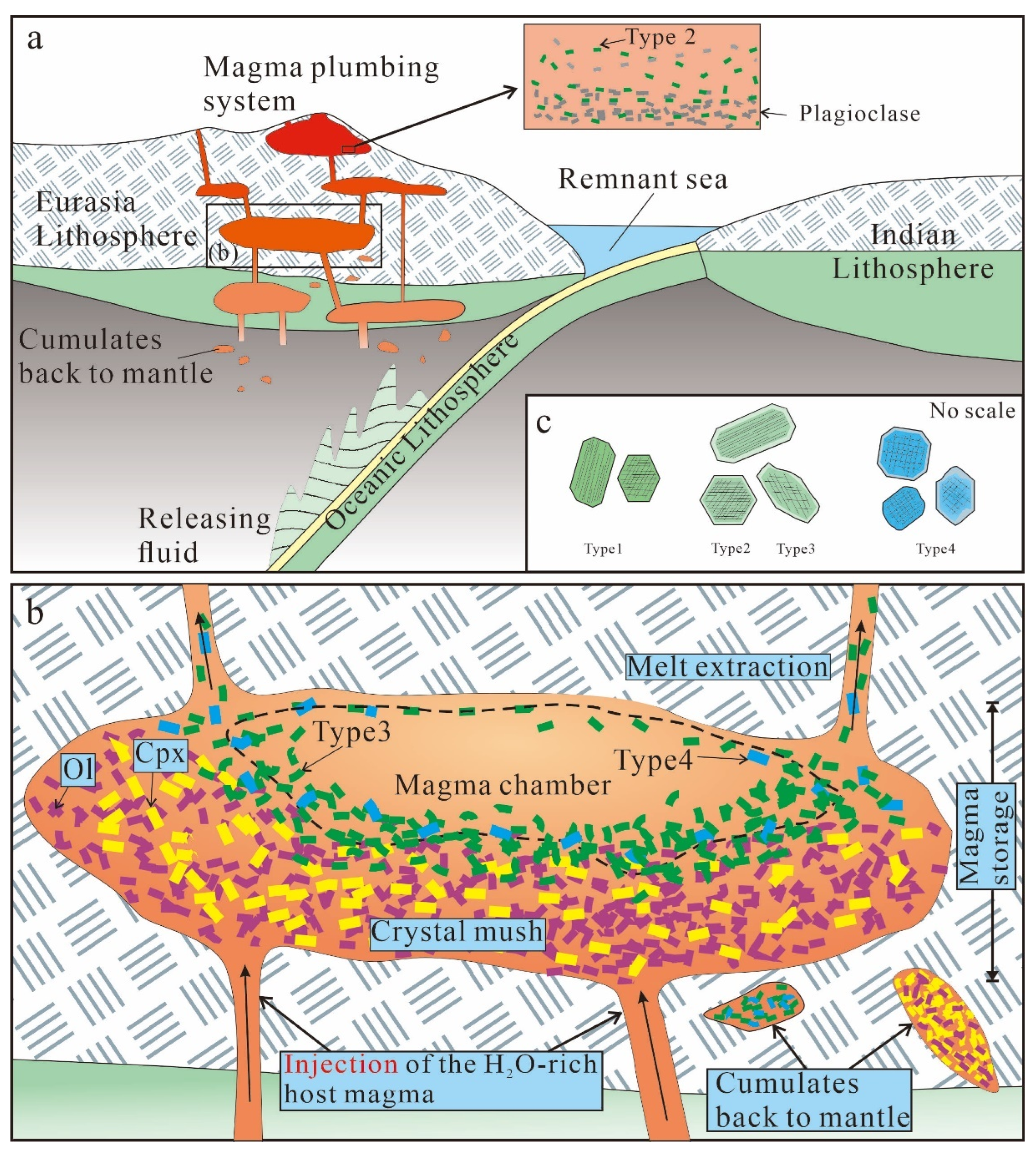
| Type | Rock | Mineral Characteristics | Habit | Representative Sample Number and Photomicrographs | |
|---|---|---|---|---|---|
| Type 1 | Fine-grained hornblende gabbro | About 0.1 mm in size, light green to light brown-yellow with obvious pleochroism, homogeneous composition without growth zoning | Euhedral | D17-B1-02, Figure 3a | |
| Type 2 | Porphyritic hornblende gabbro | 0.5–3 mm, light green to light brown with obvious pleochroism, interference colors range from second-order blue to blue-green, hexagon, with normal cleavage, partially with embayed outlines, homogeneous but a few with thin growth zoning | Euhedral/subhedral | D17-B1-01, Figure 3b,e | |
| Type 3 | P | Porphyritic hornblende gabbro | 0.5–3 mm, light green to light brown-yellow with obvious pleochroism, interference colors range from second-order blue to blue-green, hexagon, with normal cleavage, homogeneous but a few with thin growth zoning | Euhedral/subhedral | D17-B1-03, Figure 3b,e,f |
| C | Cumulate | 0.5–3 mm, light green to light brown-yellow with obvious pleochroism, interference colors range from second-order blue to blue-green, hexagon, short cylindrical, with normal cleavage, homogeneous without growth zoning | Euhedral/subhedral | D17-B2-01, D17-B2-02, Figure 3c,d | |
| Type 4 | P | Porphyritic hornblende gabbro | 0.5–3 mm, green to brown-yellow with obvious pleochroism, interference colors range from second-order blue to blue-green, octagon, short cylindrical, remaining clinopyroxene cleavages, with or without thin growth zoning at the edges | Euhedral/subhedral | D17-B1-04, D17-B1-05, Figure 3b,f |
| C | Cumulate | Short cylindrical, remaining clinopyroxene cleavages, green to brown-yellow with obvious pleochroism, interference colors range from second-order blue to blue-green, without thin growth zoning | Euhedral/subhedral | D17-B2-03, Figure 3c,d | |
| Type | Sample | T (°C) | P (MPa) | Continental Depth (km) | ∆NNO | logfO2 | H2Omelt (wt.%) | ||||||||||||
|---|---|---|---|---|---|---|---|---|---|---|---|---|---|---|---|---|---|---|---|
| Min | Max | Avg | Min | Max | Avg | Min | Max | Avg | Min | Max | Avg | Min | Max | Avg | Min | Max | Avg | ||
| Type 1 | D17–B1–02 | 847 | 881 | 868 | 93 | 176 | 127 | 3.5 | 6.7 | 4.8 | 1.0 | 1.3 | 1.1 | −11.5 | −11.2 | −11.4 | 5.1 | 5.6 | 5.3 |
| Type 2 | D17–B1–01 | 919 | 1018 | 978 | 139 | 514 | 341 | 5.3 | 19.4 | 12.9 | 0.3 | 1.0 | 0.7 | −10.8 | −9.3 | −9.8 | 4.4 | 5.9 | 4.9 |
| Type 3P | D17–B1–03 | 912 | 1035 | 1011 | 290 | 767 | 632 | 11.0 | 29.0 | 23.9 | 0.2 | 0.8 | 0.5 | −10.8 | −8.8 | −9.5 | 5.5 | 7.2 | 6.5 |
| Type 3C | D17–B2–01 | 984 | 1051 | 1030 | 457 | 804 | 660 | 17.3 | 30.4 | 24.9 | 0.5 | 0.9 | 0.6 | −9.7 | −8.7 | −9.0 | 5.6 | 6.9 | 6.3 |
| D17–B2–02 | 959 | 1034 | 1010 | 293 | 804 | 622 | 11.1 | 30.4 | 23.5 | 0.6 | 1.0 | 0.8 | −9.9 | −8.8 | −9.1 | 4.9 | 6.8 | 5.8 | |
| Type 4P | D17–B1–04 | 954 | 1062 | 1035 | 123 | 780 | 633 | 4.6 | 29.5 | 23.9 | 0.4 | 0.9 | 0.5 | −10.3 | −8.5 | −9.0 | 5.3 | 7.3 | 6.7 |
| D17–B1–05 | 962 | 1025 | 1000 | 289 | 751 | 577 | 10.9 | 28.4 | 21.8 | 0.1 | 1.3 | 0.4 | −10.1 | −8.9 | −9.7 | 5.1 | 7.4 | 6.5 | |
| Type 4C | D17–B2–03 | 965 | 1038 | 1018 | 470 | 872 | 626 | 17.8 | 33.0 | 23.7 | 0.4 | 0.8 | 0.6 | −10.0 | −8.9 | −9.2 | 5.2 | 6.6 | 5.8 |
Disclaimer/Publisher’s Note: The statements, opinions and data contained in all publications are solely those of the individual author(s) and contributor(s) and not of MDPI and/or the editor(s). MDPI and/or the editor(s) disclaim responsibility for any injury to people or property resulting from any ideas, methods, instructions or products referred to in the content. |
© 2024 by the authors. Licensee MDPI, Basel, Switzerland. This article is an open access article distributed under the terms and conditions of the Creative Commons Attribution (CC BY) license (https://creativecommons.org/licenses/by/4.0/).
Share and Cite
Jiang, X.; Luo, Z.; Liu, X. The Petrogenesis and Geological Implications of the Sanggeda Gabbros, Southern Tibet: Insights from the Amphibole Crystal Population. Appl. Sci. 2024, 14, 8435. https://doi.org/10.3390/app14188435
Jiang X, Luo Z, Liu X. The Petrogenesis and Geological Implications of the Sanggeda Gabbros, Southern Tibet: Insights from the Amphibole Crystal Population. Applied Sciences. 2024; 14(18):8435. https://doi.org/10.3390/app14188435
Chicago/Turabian StyleJiang, Xiumin, Zhaohua Luo, and Xiao Liu. 2024. "The Petrogenesis and Geological Implications of the Sanggeda Gabbros, Southern Tibet: Insights from the Amphibole Crystal Population" Applied Sciences 14, no. 18: 8435. https://doi.org/10.3390/app14188435
APA StyleJiang, X., Luo, Z., & Liu, X. (2024). The Petrogenesis and Geological Implications of the Sanggeda Gabbros, Southern Tibet: Insights from the Amphibole Crystal Population. Applied Sciences, 14(18), 8435. https://doi.org/10.3390/app14188435





